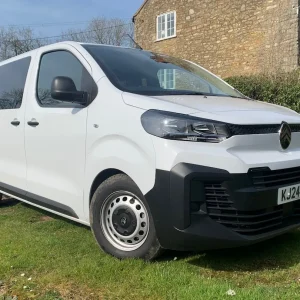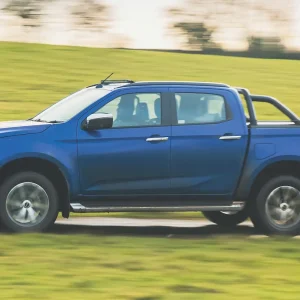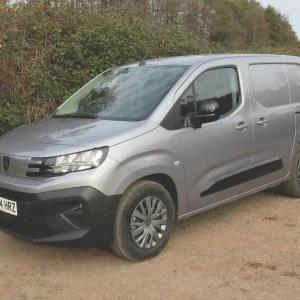The Citroen Dispatch and Peugeot Expert have both undergone a major revamp, replacing ageing models that had long passed their sell-by date.
Whereas the old models shared the same basic design as Fiat Professional’s Scudo, this time around Citroen and Peugeot’s parent PSA has parted company with the Italian manufacturer. Fiat has forged links with Renault instead and is replacing the Scudo with a re-badged Trafic under the Talento banner.
The Trafic is, of course, also sold by Vauxhall as the Vivaro, and Nissan will soon be marketing its variant as the NV300.
Fundamentally the same vehicle, the new Dispatch and Expert, like their predecessors, will also be sold by Toyota as the Proace. All three vans are distinguished by external styling differences, and while the Dispatch has a soft, friendly look to it with headlamps mounted high up and a short bonnet, the Expert has a more aggressive appearance. The Proace is more in tune with Toyota’s current house style.
Customers for the new Dispatch/Expert/Proace are faced with a van with one roof height but three body lengths with up to 6.6m3 of cargo space. Payload capacity is up by around 200kg compared with the previous offering, and power comes courtesy of either a 1.6-litre (95hp, 115hp) or 2.0-litre diesel (120hp, 150hp, 180hp).
We decided to sample Citroen’s Dispatch Enterprise M BlueHDi 120, which has, as its designation suggests, 120hp on tap.
M denotes the middle body length, with XS and XL either side, and Enterprise is the middle-ranking trim. X is the entry-level specification while Enterprise Plus sits at the top of the line-up.
All Dispatches are sold with the BlueHDi label and are fitted with stop/start. The aim is to reduce engine idling in traffic jams and at the lights, thereby cutting fuel usage and CO2 emissions.
The Dispatch is not sold solely as a van – it comes as a crew van too, as a nine-seater Combi, and as a platform cab for special conversions.
Load area
Access to the cargo bay is by means of twin rear doors plus a sliding door on each side.
On our model the side doors operated electrically. It’s an extra-cost option and one seldom if ever seen on a van until now. To open and close them you press buttons on the key fob or on the dashboard.
Our Dispatch was one of the very first to arrive in the country and Citroen was, alas, unable to give us any option prices at the time of writing, and the website’s price list was still for the outgoing model in late September.
A sensor can be installed beneath the vehicle, which you wave your foot under to operate the doors if you have an armful of parcels – assuming you have the fob in your pocket.
If it looks as though you are about to get your hand trapped between the moving door and the B pillar, then do not panic: push the edge of the door firmly and it will go backwards.
Operated manually, the rear doors can be swung through 90º, and through 180º if you undo the easy-to-release stays, which open to reveal a 5.3m3 load area with a full-height, opaque steel bulkhead to prevent items sliding forward and finishing up in the cab.
At the bottom of the bulkhead is a flap that can be folded down to allow extra-long items to be slid beneath the nearside passenger seat (the cab is a three-seater). It extends the cargo bed by 1162mm if you load all the way through to the footwell.
Six tie-down points are provided plus a 12V power point close to the rear doors on the nearside. The floor is protected by a tailored cover, and part-panelling on the doors and sides gives them some protection against minor scratches and scrapes. However, the bare wheel boxes remain vulnerable to damage.
It is worth noting that the towing limit is higher than it was with the previous model, at 2500kg as opposed to 2000kg, while the van’s overall height of 1.9m will ease access to multistorey car parks.
Cab and equipment
Housing three-abreast in a cab of this size is always going to be a squeeze and the new Dispatch is no exception. The centre passenger’s legroom is limited, with the occupant’s right knee jammed against the moulding, which bulges out from the dashboard to accommodate the gear lever.
Fold down the centre section of the middle seat back and twizzle it around and it turns into a useful little desk. It’s big enough to accommodate a laptop and comes complete with a tray to hold USB sticks and other bits and pieces, and an elasticated band to keep paperwork tidy.
Fold the middle seat cushion back and you will find an oddly shaped hidden compartment that you could use to stash a smartphone. Tug a strap at the bottom of the outboard passenger seat and you can fold it upwards to create extra space on the cab floor for parcels, thereby adding a notional 0.5m3 to your load cube. All this passenger seat configurability is provided under the Moduwork banner.
Other storage facilities include three bins in each door, the two lowest of which are difficult to reach when the doors are shut because the seats are so close to them. That is one of the penalties you pay if you try to shoehorn three seats into a cab that is really only a two-seater.
The handbrake lever sits between the driver and passenger seats. On the previous model it was, somewhat eccentrically, positioned between the driver’s seat and the door.
You can make use of a lidded, but not lockable, glovebox with a shelf below it; a lidded compartment on top of the fascia; and a shelf in the middle of the dashboard close to a 12V power point and a USB port. Another 12V socket can be found in a cubbyhole in front of the passengers along with an audio jack.
Two cup-holders sit on top of the fascia, one of which plays host to a removable ashtray.
Electric windows and heated and electrically adjustable exterior mirrors are fitted, as are a highly effective air-conditioning system, cruise control with a variable speed limiter, and an alarm.
A seven-inch colour touchscreen allows you to select your radio station – DAB is included in the deal – as part of a package that includes Bluetooth and wi-fi connectivity. There are remote controls on the steering column.
MirrorLink enables you to connect a smartphone to the touchscreen so you can see whatever the phone is displaying.
An optional camera allows you to spot what is directly behind when you engage reverse, displaying the image on the touchscreen. The image is a split one, with half of it giving a bird’s-eye view of the top of the van and any obstructions around it. Front and rear parking sensors are provided too as part of the Park Assist package.
Both the steering wheel and the driver’s seat are height-adjustable, and the latter features lumbar adjustment. Driver and passenger airbags are present as are electronic stability control, ABS, and all the usual onboard electronic safety systems.
The Dispatch can be specified with a variety of other safety devices including Driver Attention Alert (wakes the driver up if he’s nodding off); Active Safety Brake (applies the brakes in an emergency if the driver fails to); and Smart Beam (switches between high and low headlight beams depending on traffic). It
is also available with Connect Nav satellite navigation with voice operation.
Powertrain
Married to a six-speed manual gearbox, the four-cylinder 16-valve turbocharged diesel engine’s maximum power output kicks in at 3750rpm. Top torque of 340Nm bites at 1750rpm.
Compliance with the Euro6 exhaust emission rules means that the van will have to be topped up with AdBlue periodically. The 22.4-litre reservoir’s filler point is concealed by the passenger door and the claimed range between refills is 9320 miles.
Chassis and steering
Disc brakes are installed all round and our Dispatch’s 16-inch steel wheels were shod with 215/65 R16C Michelin Agilis 51 tyres. Pseudo MacPherson-type suspension is installed at the front with an anti-roll bar while an oblique wishbone suspension helps support the rear.
Power-assisted steering delivers a 12.4m turning circle between kerbs, increasing to 12.9m between walls.
Performance
Keyless ignition is fitted so you need to hit the start button on the dashboard with the fob present to fire up the engine.
There is no denying that the 120hp diesel is highly responsive, with ample torque on tap at just the right engine speed. A surprisingly smooth gear change helps you get the best out of what is on offer, and once you slot into top gear you discover that this Dispatch is perfectly happy cruising at speed on the motorway.
Nor does it create too much internal noise as it goes about its business – the in-cab decibel level stays comfortably low.
Few vans can truly cope with the potholes that pepper Britain’s highway network but the Dispatch copes better than most. Its handling is almost on a par with what is on offer from Ford’s impressive Transit Custom with steering that reacts in just the right way no matter whether you are taking a bend at speed or trying to wriggle into a tight city centre parking space.
Cyclists and other vulnerable road users will welcome Dispatch’s blind spot monitor, which alerts the driver to their presence if they come up unseen on the van’s nearside. Worthy of applause too is the (optional) heads-up digital speed display. Popping up at the bottom of the windscreen, it tells you how fast you are travelling without the need to take your eyes off the road to glance at the speedo. If you find it a distraction then you can hit a button and it will retract into the top of the dashboard.
Buying and running
The Dispatch comes with a three-year/100,000-mile warranty with no mileage limit for the first two years. Roadside assistance is included for the first 12 months, while service intervals are set at two years/25,000 miles.
We averaged around 45mpg, well within sight of the official combined fuel economy figure of 53.3mpg. An early right-hand drive model, our vehicle did not, alas, have stop-start fitted, which would have improved the figure, but Citroen states that versions sold by its dealers will.
Side-rubbing strips are set low down on the van’s sides and should help protect the vehicle from minor damage. Like the mirror casings, the front and rear bumpers and the door handles, they were colour-keyed to match the rest of the vehicle on our demonstrator as part of an optional Look Pack. It also includes vertical LED daytime running lights and front fog lights. Our van was finished in optional metallic paint.
| Price (ex VAT) | £21,165 |
| Price range (ex VAT) | £17,915-£26,965 |
| Gross payload | 1487kg |
| Load length | 2512mm |
| Load width (min/max) | 1258/1628mm |
| Load bay height | 1397mm |
| Load volume | 5.3m3 |
| Loading height | 613mm |
| Rear door aperture | 1282x1220mm |
| Side door aperture | 935x1241mm |
| Gross vehicle weight | 3100kg |
| Braked trailer towing weight | 2500kg |
| Residual value | 16.9%* |
| Cost per mile | 40.9p* |
| Engine size | 1997cc, 120hp@3750rpm |
| Torque | 340Nm@1750rpm |
| Gearbox | 6-speed manual |
| Fuel economy | 53.3mpg (combined) |
| Fuel tank | 70 litres |
| CO2 | 139g/km |
| Warranty | 3yrs/100,000mls |
| Service intervals | 2yrs/25,000mls |
| Insurance group | 38E |
History:
Sold as the Jumpy outside the UK, the original Dispatch first appeared 22 years ago with a 4.0m3 cargo area, one loadbed length and one roof height.
It formed part of a joint venture between PSA and Fiat and was also sold as the Peugeot Expert and Fiat Scudo.
It remained in production until 2006 when it was replaced by a model that covered a far wider section of the market. The new Dispatch came with three load cubes – 5.0m3, 6.0m3 or 7.0m3 – and a payload capacity of 1000–1200kg depending on the model chosen.
Like its predecessor, it was produced as the Expert and Scudo, and more latterly as the Toyota Proace. The new model made its public debut at April’s CV Show in Birmingham.





